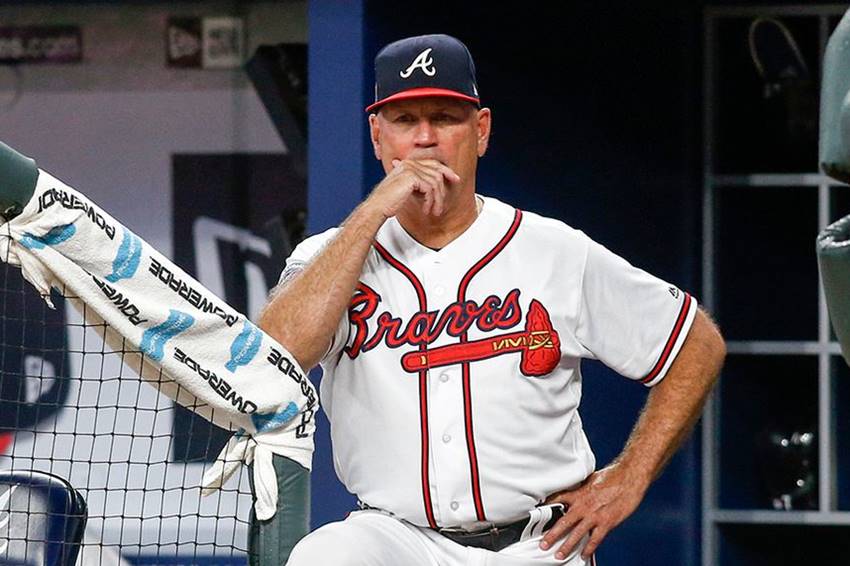
The Braves have a few more prep prospects to sign away from commitments than usual.

The three days of the 2024 MLB Draft are over, and no one saw this coming for the Atlanta Braves. The Braves managed to move the top high school pitcher in the country, Cam Caminiti, down to the 24th pick, and the big question now is how much it will cost to pull him away from his LSU pledge. All indicators are that he and the Braves’ top ten picks are certain to sign, but we’ve seen things go wrong at the last second.
Caminiti is expected to take an over slot bonus and eat up more than half of the pool by himself, and he is not the only one we could be looking at over slot bonuses for.
This season, the Braves have a limited pool of $7,765,000 and will have to steal top three round picks Carter Holton and Luke Sinnard away from their last years of college eligibility. Nick Montgomery and Ethan Bagwell are the last two prominent names in terms of real pool allotment. Both are the Braves’ prep picks in the fifth and sixth rounds, and both are likely to come with over-slot bonuses. Montgomery is a player we’re all enthusiastic about, a California catcher with a lot of natural power who we hope will flourish in a system that has produced three notable catcher prospects in recent seasons (Shea Langeliers, William Contreras, and Drake Baldwin).
Bagwell is a pitcher out of an Illinois high school who has major arm talent but will be a significant developmental prospect for a Braves organization who has had some success with guys in that vein like AJ Smith-Shawver and Spencer Schwellenbach.
Update since I forgot to mention it: The signing deadline is Thursday, August 1st at 5:00 pm ET.
Undrafted Free Agents
| Name | Position | School |
|---|---|---|
| Derek Vartanian | RHP | Campbell |
| Mac Guscette | C | Alabama |
| Jacob Gomez | LHP | Old Dominion |
The Braves may also have some challenging signs in the latter ten rounds, but this will have less of an impact on the draft overall because unsigned picks do not affect the total pool. For those who are unaware, in the top ten rounds, each pick receives a bonus that counts toward a team’s overall pool. This total pool number is utilized to sign all picks, although for the last ten rounds, each pick can sign for up to $150,000 without exceeding that amount. Any amount less than $150,000 is not considered savings, but any amount greater than that will be counted against the pool total.
The primary candidates to consider in this regard are 12th round pitcher Cayman Goode, 15th round outfielder Owen Carey, and 20th round outfielder Eric Hartman. All three must be signed away from D-1 commitments, which may be difficult signs, and the Braves have a larger chance than in previous years of not signing all of their picks. 14th-round shortstop Colby Jones, a junior college talent with a Division I commitment, might possibly play a role.
They may also have some trouble with the three juniors in the later rounds, who could return to school like 12th rounder Brady Day did last season, however these 11th to 20th round juniors normally sign and do not open themselves up to becoming senior signs in the following years. Senior signees in those last day two picks frequently receive five or even four figure incentives because they lack the signing power of being able to return to college, making the $150k day three cap an appealing offer.
Now, the bonus pool is not a hard limit on spending. Technically, if a team wanted to, they could spend anything they wanted as long as they were willing to suffer the consequences. The most significant statistic to know about signing bonuses is the 5% overage, as shown in the table, which is the limit that the Braves will not surpass. Any money spent between 100% and 105% will be subject to a 75% luxury tax on those bonus values, but anything above 5% would result in the Braves giving up a future first-round draft pick, which is not worth the benefit of signing players to them.
Any player from the first ten rounds who does not sign will have their slot value deducted from the overall bonus pool, therefore teams usually have all of those picks ready to sign before even picking them.
Another thing you may notice is that many of the numbers start with “$1,297,500”. Each pick includes a $2,500 contigency incentive, which some teams may award to players in addition to their main bonus, while others, like as the Braves, will take from the official bonus to conserve money in the pool. The player receives the $2,500 anyway, which is especially relevant for senior signees, who may see their bonus treble the “official” amount. The final rule that applies is the minimum signing bonus. Players that attend the draft combine and undergo a pre-draft medical evaluation must get at least 75% of their slot value.
Each of the Braves’ first six picks attended the combine, but this rule may only apply to Herick Hernandez, who is the only one who may potentially receive an under-the-slot signing bonus. Then then, I said the same thing to Drue Hackenberg last season, and he went way over slot on his bonus, so we may frequently be quite wrong about our bonus predictions.
Consider the worst-case scenario: the Braves are unable to reach an agreement with Caminiti. What does a medical red flag, a change of heart, or agent antics imply for the Braves? If a player in the first two rounds of the draft (such as Caminiti or Holton) does not sign and is offered at least 40% of the slot value by the drafting team, the team will receive a pick from the same round, one spot later in the upcoming round. The Braves did not sign Carter Stewart (medicals) with the eighth overall pick in 2018, so they received the ninth overall pick in 2019.
Should a third round pick not sign, the team receives a compensation pick after the end of the third round.
First big bonus out of the way
2nd-rder Carter Holton signs w/@Braves for $1,350,000 (pick 62 value = $1,385,000). @VandyBoys LHP, 93-95 to 98 w/fastball, low-80s slider, upper-70s curve, mid-80s changeup with sink. @MLBDraft pic.twitter.com/3xz5GU0mol
— Jim Callis (@jimcallisMLB) July 17, 2024
Two more big bonuses in today.
The #Braves signed 6th rounder Ethan Bagwell for $822,500. Slot value for the 191st pick is $312,800.
— Carlos Collazo (@CarlosACollazo) July 18, 2024
3rd-rder Luke Sinnard signs w/@Braves for $735,300 (slot 99 = $737,800). @IndianaBase RHP, missed this spring following TJ surgery, potential top-2-rds guy before that, 6-ft-8/250, 91-96 mph fastball w/high spin & carry, both his curve & slider are effective. @MLBDraft
— Jim Callis (@jimcallisMLB) July 18, 2024





